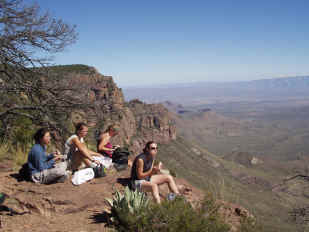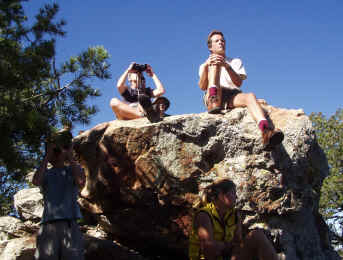

|
|
|
![]()
Bringing students to Big Bend National Park for a field trip can be an incredibly rewarding experience. It requires, however, a great deal of preparation ahead of time. The following is a list of suggestions for planning your own trip.
I. Pre-trip Planning
∑ Start early! The logistics of reaching Big Bend National Park and the distances involved require pre-trip planning. A well-organized trip can make the difference between a successful experience and a difficult one.
∑ Reserve camping ahead of time. Group campsites are the ONLY camping in the park that can be reserved ahead of time. Sites are located at Rio Grande Village, the Basin, and Cottonwood Campgrounds. The only showers in the park are located at the Rio Grande Village store. Group campsites can be reserved 90 days in advance by calling 432-477-1188. During our busy season (November-May), you should call for camping reservations as early as possible.
∑ Request an educational fee waiver. The park entrance fee is $10 per vehicle and is valid for a week. Educational groups are eligible for an entrance fee waiver if certain criteria are met. Contact the parkís fee supervisor at 432-477-1121 to see if your group is eligible.
∑ Volunteer your time. Big Bend staff is always looking for eager volunteers to help us with various projects. Consider spending part of your time here helping preserve this amazing resource! Contact the volunteer coordinator at 432-477-1195 to find out about volunteer opportunities.
∑ Involve your students in the planning process. Discuss the itinerary, transportation, meals, and lodging/camping plans with your class. This gives them responsibility and ownership of the trip and heightens their anticipation.
∑ Have a pre-trip meeting with parents/chaperones. Discussing trip plans with adults will help gain their support, ease concerns, and facilitated signatures on permission slips. A suggested ratio of chaperones to students for elementary age is 1:5. For secondary students the suggested ratio is 1:10.
∑ Gather Information. Have students write the park for information. Check out the parkís website at www.nps.gov/bibe. Investigate learning opportunities near Big Bend National Park like The Museum of the Big Bend on the Sul Ross State University campus in Alpine, the McDonald Observatory near Fort Davis, and the Barton Warnock Environmental Education Center and Big Bend Ranch State Park near Lajitas.
∑ Incorporate trip information into lesson plans. Many aspects of your upcoming trip can be discussed in a variety of classes and subjects. Be creative! Map out the directions to Big Bend as a geography lesson. Calculate the tripís budget in math class. Start trip journals as a writing assignment.
∑ Consider focusing on one theme. Big Bend is such a huge place that it is impossible to see it all at one time. Planning a trip around one broad theme like biodiversity, geology, or the Rio Grande may make organization easier and help students get the most out of their trip.

∑ Be ready for anything. How to dress is dependent on the season and the weather. It can be extremely hot or cold and sometimes it rains and snows! Everyone should be prepared to spend time outdoors under a broad range of conditions. Check on existing weather conditions prior to leaving by looking at our daily report on the website.
∑ Water and more water! One of the biggest concerns while visiting Big Bend is dehydration. Make sure everyone in the group is drinking adequate amounts of water. Bring water bottles whenever you are hiking and encourage students to drink frequently.
∑ Other essentials. Everyone should bring a hat and sunscreen to protect themselves from the sunís strong rays. A flashlight is handy for nighttime around camp. Snacks to share for hikes and long car rides are nice. Bring along some games and sports equipment for down time at camp.
∑ First aid. Of course, safety and health are of primary concern. A good first aid kit is required. Include a blister kit and tweezers for removing cactus spines. Establish a system for students to bring and take any prescription medication that they might need.
∑ Swimming. The Rio Grande may look inviting on hot days, but swimming is not recommended. Strong currents, high pollution levels, and objects hidden under the water can make swimming a dangerous prospect.
∑ Desert hazards. Everyone in the group should be aware of dangers like loose rocks, cactus spines, insects, and reptiles. A safety talk upon arrival is a good idea. Remember that all objects in a national park are protected by law and should not be disturbed or damaged.

∑ Check out the visitor center. Park headquarters at Panther Junction is a good place to get oriented to Big Bend. A relief map, interpretive displays, and bookstore provide excellent information. A short, self-guided nature walk will familiarize students with the local flora. Panther Junction Visitor Center is open from 8:00am-6:00pm daily. Other visitor centers are located at the Chisos Basin, Persimmon Gap, and Rio Grande Village.
∑ Go to a program with a ranger. Park rangers offer daily interpretive programs on a variety of topics. Programs include walks, talks, hikes, and evening slide presentations. Check the interpretive activity schedule on park bulletin boards for times and topics. The schedule is also posted on the website for planning prior to your arrival.
∑ Take a hike! Big Bend has hundred of miles of trails for you to explore. They range greatly in distance and difficulty. Some trails are self-guided with trail brochures to enhance your experience.
∑ Become Junior Rangers. Junior Ranger activity books are sold at park visitor centers for $1.00. By completing the activities in the book, students can earn badges, patches, bookmarks, and certificates. Itís a good way of learning more about the park during your visit.
∑ Be flexible. Donít get frustrated if everything doesnít go exactly as planned. Some of the best teachable moments are unplanned. Take advantage of opportunities as they arise.
IV. Post-trip Follow Up
∑ Conduct post-visit activities. Follow up the experience by building on student observations during the trip. Discuss what they saw and what they learned. Use their new knowledge in future lesson plans.
∑ Discuss overall trip impressions with your students. What were their favorite parts of the trip? What didnít they enjoy? Discuss improvements for future trips. Keep a list of these suggestions and refer to them for next time.
∑ Share your experience with others. Typically, only a small percentage of students are able to participate in field trips. Those not fortunate enough to visit Big Bend can still learn from the experience. Have students present trip reports to classmates. Create a bulletin board at school with photos and trip highlights. Give awards at an assembly to recognize student efforts (best hiker, best cook, most helpful, etc.).
∑ Give thanks! Remember to thank parents and chaperones for their help with the trip. Praise your students for meeting mental and physical challenges successfully. Acknowledge the collective and individual rewards that come with outdoor adventures. Pat yourself on the back for a trip well done!!